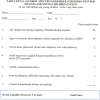Screening for fetal alcohol spectrum disorder in infants and young children
- PMID: 38389826
- PMCID: PMC10880768
- DOI: 10.3389/adar.2023.11125
Screening for fetal alcohol spectrum disorder in infants and young children
Abstract
Introduction: With an estimated prevalence of up to five percent in the general population, fetal alcohol spectrum disorders (FASD) are the most common neurodevelopmental disorder and more prevalent than autism. Early identification and subsequent early intervention have the potential to improve developmental trajectory of children with FASD. In addition, new research suggests supplementation with choline may ameliorate the developmental impairments associated with prenatal alcohol exposure. Availability of a screening tool with acceptable epidemiologic performance criteria may be clinical useful in identification of young children at increased risk for FASD. In this paper we describe the Early Fetal Alcohol Spectrum Disorder Screening Test (E-FAST) to identify young children at increased risk for an FASD. Methods: We developed the E-FAST dataset from previously published studies, comprised of 281 children under 5 years of age, 180 (64.1%) were diagnosed with FASD and 101 (35.9%) were non-FASD. Analysis: The analysis identified seven useful variables (prenatal alcohol exposure, ADHD (Attention Deficit Hyperactivity Disorder), foster care or adopted, small OFC (occipital frontal circumference), communication impairments, impaired social skills, and cognitive deficits. All variables were categorized as yes/no for ease of use in a screening tool. Risk ratios for each of the seven indicators were estimated using two-way table analyses. Weights for each variable were estimated based on the relative strength of their odds ratios. Results: The average age was 2.7 years of age (S.D. 1.29) and ranged from infant (6.4%) to 4 years old (35.9%). Maternal alcohol use alone had a sensitivity of 0.97, specificity 0.65, and accuracy 0.86. For the combined seven variables, sensitivity was 0.94, specificity 0.74, and accuracy 0.87. Thus, the seven-item E-FAST screen had acceptable epidemiologic screening characteristics. Discussion: In the United States, up to 547 infants with FASD are born each day which far exceeds the capacity of multidisciplinary diagnostic clinics. During routine clinical management of infants and young children the use of an evidence-based screening tool provides a time efficient means to exclude large numbers of young children from further follow-up for FASD. Conversely, a positive screen identifies a smaller number of children at increased risk for FASD requiring more intensive evaluation and follow-up.
Keywords: fetal alcohol spectrum disorder; infancy; neurodevelopmental disorder; prenatal alcohol exposure; screening.
Copyright © 2023 Fleming, Sheridan, Waite, Klug and Burd.
Conflict of interest statement
The authors declare that the research was conducted in the absence of any commercial or financial relationships that could be construed as a potential conflict of interest.
Figures



Similar articles
-
Identifying the behavioural phenotype in Fetal Alcohol Spectrum Disorder: sensitivity, specificity and screening potential.Arch Womens Ment Health. 2006 Jul;9(4):181-6. doi: 10.1007/s00737-006-0130-3. Epub 2006 May 3. Arch Womens Ment Health. 2006. PMID: 16673042
-
Common developmental trajectories and clinical identification of children with fetal alcohol spectrum disorders: A synthesis of the literature.Adv Drug Alcohol Res. 2023 Apr 3;3:10877. doi: 10.3389/adar.2023.10877. eCollection 2023. Adv Drug Alcohol Res. 2023. PMID: 38389815 Free PMC article.
-
Prevalence of fetal alcohol spectrum disorder in Greater Manchester, UK: An active case ascertainment study.Alcohol Clin Exp Res. 2021 Nov;45(11):2271-2281. doi: 10.1111/acer.14705. Epub 2021 Sep 29. Alcohol Clin Exp Res. 2021. PMID: 34590329 Free PMC article.
-
Choline Supplementation for Infants, Children, and Pregnant People: Rapid Review [Internet].Ottawa (ON): Canadian Agency for Drugs and Technologies in Health; 2024 Jun. Report No.: RC1531. Ottawa (ON): Canadian Agency for Drugs and Technologies in Health; 2024 Jun. Report No.: RC1531. PMID: 39088668 Free Books & Documents. Review.
-
Prevalence of fetal alcohol spectrum disorder in foster care: A scoping review.Alcohol Clin Exp Res (Hoboken). 2024 Aug;48(8):1443-1450. doi: 10.1111/acer.15394. Epub 2024 Jun 20. Alcohol Clin Exp Res (Hoboken). 2024. PMID: 39031634
References
-
- Grant BF, Chou SP, Saha TD, Pickering RP, Kerridge BT, Ruan WJ, et al. Prevalence of 12-month alcohol use, high-risk drinking, and DSM-IV alcohol use disorder in the United States, 2001-2002 to 2012-2013: Results from the national epidemiologic survey on alcohol and related conditions. JAMA Psychiatry (2017) 74(9):911–23. 10.1001/jamapsychiatry.2017.2161 - DOI - PMC - PubMed
LinkOut - more resources
Full Text Sources

